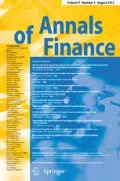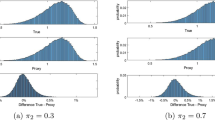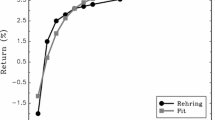Abstract
This paper challenges the use of stocks in portfolio construction, instead we demonstrate that Asian derivatives, straddles, or baskets could be more convenient substitutes. Our results are obtained under the assumptions of the Black–Scholes–Merton setting, uncovering a hidden benefit of derivatives that complements their well-known gains for hedging, risk management, and to increase utility in market incompleteness. The new insights are also transferable to more advanced stochastic settings. The analysis relies on the infinite number of optimal choices of derivatives for a maximized expected utility theory agent; we propose risk exposure minimization as an additional optimization criterion inspired by regulations. Working with two assets, for simplicity, we demonstrate that only two derivatives are needed to maximize utility while minimizing risky exposure. In a comparison among one-asset options, e.g. American, European, Asian, Calls and Puts, we demonstrate that the deepest out-of-the-money Asian products available are the best choices to minimize exposure. We also explore optimal selections among straddles, which are better practical choice than out-of-the-money Calls and Puts due to liquidity and rebalancing needs. The optimality of multi-asset derivatives is also considered, establishing that a basket option could be a better choice than one-asset Asian call/put in many realistic situations.






Similar content being viewed by others
Notes
This can easily be extended to other utility functions.
See “Appendix A.9" for analysis of other parameter choices.
\(\frac{\partial O_t^{(i,j)}}{\partial K^{(i,j)}}\) on boundary is defined as the one-sided derivative.
We assume stocks which pay no dividends, so American call is identical to the European call in (a). In addition, the allocation on American put is shown in (b) when \(K^{(2,Amer\ Put)}<37.7\), i.e. the region, in which the American put should be held and not yet exercised.
The actual range of American put strike price is the intersection of \([A^{(i,Amer\ Put)},B^{(i,Amer\ Put)}]\) and the region of \(K^{(i,Amer\ Put)}\) such that the option is not exercised immediately, hence American option is not considered when \([A^{(i,Amer\ Put)},B^{(i,Amer\ Put)}]\) is mutually exclusive with that region.
Investor can choose the weight on each asset of basket option in OTC market, we only consider equal weighted case in this paper.
References
Bertsimas, D., Tsitsiklis, J.N.: Introduction to Linear Optimization, Vol. 6. Athena Scientific Belmont, MA (1997)
Bjerksund, P., Stensland, G.: Closed-form approximation of American options. Scand J Manage 9, S87–S99 (1993)
Black, F., Scholes, M.: The pricing of options and corporate liabilities. J Polit Econ 81(3), 637–654 (1973)
Chen, N., Liu, Y.: American option sensitivities estimation via a generalized infinitesimal perturbation analysis approach. Oper Res 62(3), 616–632 (2014)
Goldman, M.B., Sosin, H.B., Gatto, M.A.: Path dependent options:" buy at the low, sell at the high". J Finance 34(5), 1111–1127 (1979)
Haugh, M.B., Lo, A.W.: Asset allocation and derivatives. Quant Finance 1, 45–72 (2001)
Kemna, A.G., Vorst, A.C.: A pricing method for options based on average asset values. J Bank Finance 14(1), 113–129 (1990)
Kraft, H.: Elasticity approach to portfolio optimization. Math Methods Oper Res 58(1), 159–182 (2003)
Liu, J., Pan, J.: Dynamic derivative strategies. J Financ Econ 69(3), 401–430 (2003)
Maverick, J.: How Big is the Derivatives Market? https://www.investopedia.com/ask/answers/052715/how-big-derivatives-market.asp (2020)
Merton, R.C.: Lifetime portfolio selection under uncertainty: The continuous-time case. Rev Econ Stat, 247–257 (1969)
Merton, R.C.: Theory of rational option pricing. Bell J Econ Manage Sci, 141–183 (1973)
Mi, H., Xu, L.: Optimal investment with derivatives and pricing in an incomplete market. J Comput Appl Math 368(112), 522 (2020)
Rardin, R.L., Rardin, R.L.: Optimization in Operations Research, Vol. 166. Prentice Hall Upper Saddle River, NJ (1998)
Author information
Authors and Affiliations
Corresponding author
Additional information
Publisher's Note
Springer Nature remains neutral with regard to jurisdictional claims in published maps and institutional affiliations.
Appendix A Proofs
Appendix A Proofs
1.1 A.1 Proof of Proposition 1
We assume \(V(t,W)=\frac{W_t^{1-\gamma }}{1-\gamma }\exp (h(T-t))\), which is substituted into (6). Then, \(h(T-t)\) satisfies:
Denote \({\varvec{\eta _t}}={\varvec{\Sigma _t}}^T{\varvec{\pi _t}}\), then problem (A1) can be rewritten as,
which implies the optimal strategy
With \({\varvec{\eta ^*_t}}={\varvec{\Sigma _t}}^T{\varvec{\pi ^*_t}}\), there are infinitely many choice of \({\varvec{\pi _t}}^*\) if \(n>2\). Next, we substitute \({\varvec{\eta ^*_t}}\) into (A2) and derive the ordinary differential equation (ODE) for \(h(T-t)\):
where the terminal condition results from \(V(t,W)=U(W)\). The solution to (A4) is
1.2 A.2 Proof of Proposition 2
Let \({\varvec{O_{t,n}}}=[O^{(1)}_t, O^{(2)}_t,\ldots , O^{(n)}_t]^T\) with variance matrix \(\Sigma _t\) of rank 2 be an optimal subset of options for problem (9). \({\varvec{\pi ^*_{t,n}}}\) is a strategy maximizing the expected utility if and only if \({\varvec{\Sigma }}^T_t{\varvec{\pi ^*_{t,n}}}={\varvec{\eta ^*_t}} \). Therefore, \({\varvec{O_{t,n}}}\) and \({\varvec{\pi ^*_{t,n}}}\) is an optimal pair for (9) when \({\varvec{\pi ^*_{t,n}}}\) is an optimal solution for
According to the principle 4.5 in Rardin and Rardin (1998), problem (A6) is equivalent to
where \({\varvec{\delta _t}}=[\alpha _t^{(1)},\alpha _t^{(2)},\ldots ,\alpha _t^{(n)},\beta _t^{(1)}, \beta _t^{(2)},\ldots ,\beta _t^{(n)}]^T\) satisfies \(\alpha _t^{(i)}=\frac{\vert \pi _t^{(i)}\vert +\pi _t^{(i)}}{2}\), and \(\beta _t^{(i)}=\frac{\vert \pi _t^{(i)}\vert -\pi _t^{(i)}}{2}\), with
Theorems 2.3 and 2.4 in Bertsimas and Tsitsiklis (1997) list the necessary and sufficient conditions for the extreme point \(\delta _t\), i.e.
-
1.
\({\varvec{\delta _t}}=[\delta _t^{(1)}, \delta _t^{(2)},\ldots ,\delta _t^{(n)},\delta _t^{(n+1)}, \delta _t^{(n+2)},\ldots ,\delta _t^{(2n)}]^T\).
-
2.
the \({\hat{q}}_{th}\) and \({\hat{p}}_{th}\) rows in \(\hat{\Sigma _t}\) are linear independent, \(\delta _t^{(i)}=0\) if \(i\ne {\hat{q}}\) or \({\hat{p}}\).
-
3.
\(\delta _t\) is feasible solution.
Without loss of generality, we assume the \(p_{th}\) and \(q_{th}\) rows in \(\Sigma \) are linear independent, and we consider 4 cases:
It is clear that there is a non-negative strategy in \(\delta _t^{[1]}\), \(\delta _t^{[2]}\), \(\delta _t^{[3]}\) and \(\delta _t^{[4]}\) because the \(i_{th}\) row in \({\hat{\Sigma }}\) is the opposite of the \((i+n)_{th}\) row, and the non-negative strategy is feasible and an extreme point. This proves the existence of an extreme point for problem (A7).Now, theorem 2.7 in Bertsimas and Tsitsiklis (1997) guarantees that there is an optimal solution which is an extreme point for problem (A7).
With the second necessary and sufficient conditions of the extreme point, we know that an optimal solution \(\delta _t^*\) for problem (A7) has at most two non-zero elements. This would imply an optimal solution, denoted by \({\varvec{\pi ^*_{t,n}}}=[\pi _{t,n}^{(1)}, \pi _{t,n}^{(2)},\ldots ,\pi _{t,n}^{(n)}]^T\), for problem (A6) with at most two non-zero elements, which would also be the optimal strategy for (9).
Without loss of generality, we assume \(\pi _{t,n}^{(i)}=0\), \(i\ne x,y\). \({\varvec{O_{t,2}}}=[O^{(x)}_t, O^{(y)}_t]\) and \({\varvec{\pi ^*_{t,2}}}=[\pi _{t,n}^{(x)}, \pi _{t,n}^{(y)}]^T\) is a feasible strategy for problem (9) with \(n=2\). We show that it is an optimal pair by contradiction.
If there is a feasible solution \({\varvec{{\hat{O}}_{t,n}}}=[{\hat{O}}^{(1)}_t, {\hat{O}}^{(2)}_t]\) and \({\varvec{{\hat{\pi }}^*_{t,2}}}=[{\hat{\pi }}_{t,2}^{(1)}, {\hat{\pi }}_{t,2}^{(2)}]^T\) such that \(\Vert {\varvec{{\hat{\pi }}^*_{t,2}}}\Vert _1<\Vert {\varvec{\pi ^*_{t,2}}}\Vert _1\), then \({\varvec{{\hat{\pi }}^*_{t,n}}}=[{\hat{\pi }}_{t,2}^{(1)}, {\hat{\pi }}_{t,2}^{(2)},0,\ldots \ldots ,0]^T\) is a feasible strategy for (9) such that \(\Vert {\varvec{{\hat{\pi }}^*_{t,n}}}\Vert _1<\Vert {\varvec{\pi ^*_{t,n}}}\Vert _1\), which is contradiction to our previous conclusion. Note that \(\Vert {\varvec{\pi ^*_{t,2}}}\Vert _1=\Vert {\varvec{\pi ^*_{t,n}}}\Vert _1\), so problem (9) with \(n=2\) and with \(n\ge 2\) have the same minimum \(\ell _1\) norm of allocation.
1.3 A.3 Proof of Proposition 3
Let \(O_t\in \Omega _O^{(2,1)}\) with non-singular variance matrix \({\varvec{\Sigma _t}}\) (see (11)), the optimal strategy space \(\Omega _{\pi }^{O}\) contains a unique strategy, i.e. \({\varvec{\pi _t}}=({\varvec{\Sigma _t}}^T)^{-1}{\varvec{\eta _t^{*}}}\), and \(\ell _1\) norm of \({\varvec{\pi _t}}\) is given by
A non-zero denominator is guaranteed by the non-singular variance matrix assumption. \(O_t^{*}=[O_t^{{(1)},*},O_t^{{(2)},*}]^T\in \Omega _O^{(2,1)}\) with variance matrix
For \({\varvec{O_t}}\in \Omega _O^{(2,1)}\), if \(\left| f^{(1)}_t\right| \le \left| f_t^{(1),*}\right| \) and \(\left| f^{(2)}_t\right| \le \left| f_t^{(2),*}\right| \) hold, then it is easy to see \(\left\| {\varvec{\pi _t}}\right\| _1 \ge \left\| {\varvec{\pi _t}}^{*}\right\| _1\), so \({\varvec{O_t^{*}}}\) is a optimal portfolio composition.
If \(\left| f^{(1)}_t\right| \le \left| f_t^{(1),*}\right| \) or \(\left| f^{(2)}_t\right| \le \left| f_t^{(2),*}\right| \) does not hold, then there is a \({\varvec{O^{**}_t}}\in \Omega _O^{(2,1)}\), such that the corresponding strategy \(\left\| {\varvec{\pi _t}}^{**}\right\| _1<\left\| {\varvec{\pi _t}}^{*}\right\| _1\), hence \({\varvec{O_t^{*}}}\) is not the optimal.
We have shown that, for any \({\varvec{O_t}}\in \Omega _O^{(2,1)}\), \(\left| f^{(1)}_t\right| \le \left| f_t^{(1),*}\right| \) and \(\left| f^{(2)}_t\right| \le \left| f_t^{(2),*}\right| \) is a sufficient and necessary condition for \({\varvec{O_t^{*}}}\) to be an optimal portfolio composition for problem (10). Therefore,
1.4 A.4 Proof of Proposition 4
\({\varvec{O_t^{*}}}=[O_t^{(1),*},O_t^{(2),*}]^T\) is the optimal portfolio composition for problem (10) if and only if it has the largest absolute sensitivity (see Proposition 3), i.e.
For convenience, we write the absolute sensitivity as a function of strike price \(KK^{(i,j)}\).
\(h(K^{(i,j)},j)\) is continuous because \(O_t^{(i,j)}\in {\mathbb {C}}^1\) and \(O_t^{(i,j)}\ne 0\). According to the extreme value theorem, there is a \({\hat{K}}^{(i,j)}\in [A^{(i,j)},B^{(i,j)}]\) that achieves the largest \( h(K^{(i,j)},j)\), hence minimizes \(\ell _1\) norm of allocation \(\left\| {\varvec{\pi _t}}^*\right\| _1\). \(O_t^{(i),*}\) is the optimal for problem (10) when the strike price \(K^{(i,j)}\) is one of the \({\hat{K}}^{(i,j)}\) where: \(j\in \{\textit{Euro Call, Asian Call, Amer Call, Euro Put, Asian Put, Amer Put}\}\) This guarantees the existence of optimal composition in \(\Omega _O^{(2,put\ call)}\).
1.5 A.5 Proof of Corollary 5
We first prove the following lemma,
Lemma 9
The inequality
holds for \(\forall x\in (-\infty ,\infty ), c\in (0,\infty )\), where \(\phi \) and N are respectively the density function and distribution function of a standard normal random variable.
Proof
Let us define the “reversed hazard rate” function:
We want to show
We first demonstrate \(Y^{\prime }(x)\ge -1\) for all x. To see this, note:
Using \(\phi ^{\prime }=-x\phi \), we have \(f^{\prime }=\left( 1+\frac{xN}{\phi }\right) N\) . It is not difficult to see that \(x+Y\ge 0\) (use the fact that \(g=\left( x+Y\right) N\rightarrow 0\) as \(x\rightarrow -\infty \) and \(g^{\prime }=N\ge 0\)). Hence we know \(\left( 1+\frac{xN}{\phi }\right) \ge 0\), which implies \( f^{\prime }\ge 0\). Moreover \(f(x)\ge \underset{x\rightarrow -\infty }{\lim }f(x)=0\), therefore \(Y^{\prime }+1\ge 0\).
Now we complete the proof, using \(Y^{\prime }\ge -1\) for all x, and the mean value theorem, we conclude “by contradiction” that
for all x and c, which implies
\(\square \)
Next, we show that absolute value of optimal allocation on an European call decreases to 0 as \(K^{(i,Euro\ Call)}\rightarrow \infty \) and absolute value of allocation on an European put increases with \(K^{(i,Euro\ Put)}\) and converges to 0 as \(K^{(i,Euro\ Put)}\rightarrow 0\). We first abbreviate \(K^{(i,Euro\ Call)}\) to K. Equation (12) and (15) shows the sensitivity of an European call,
where
with \(c=\sigma ^{(i)} \sqrt{{\hat{T}}-t}>0\), \(b=\frac{1}{2}c\) and \(a=\frac{1}{c}\). Let us rewrite the sensitivity as follows:
where \(x=a\left( \ln {(S_{t}/K)}+r({\hat{T}}-t)\right) {+}b\,\) and \(G(x)= \frac{N(d_{2})}{N(d_{1})}=\frac{N(x-c)}{N(x)}\).
We would like to show \( H(x)=e^{\frac{b-x}{a}}G(x)\) is increasing in K, hence decreasing in x. Its first derivative leads to:
It’s easy to see \(H^{\prime }(x)<0\) with Lemma 9. The sensitivity of an European call is positive and increases with K.
As \(K\rightarrow \infty \), \(O^{(i, Euro\ call)}_t\rightarrow 0\), so \(Ke^{-r({\hat{T}}-t)}N(d_2)\rightarrow 0\). Furthermore,
Hence,
Moreover, the absolute value of allocation on \(O_t^{(i,Euro\ Call)}\) is decreasing with K and
The proof for European put follows similarly.
1.6 A.6 Proof of Proposition 6
Suppose for any \({\varvec{O_{t}}}\in \Omega _{O}^{(2,straddle)}\), \(O_{t}^{(i,j)}\) satisfies these four conditions:

All four assumptions are not restrictive in a Black–Scholes setting. Proposition 3 illustrates that \({\varvec{O_t^{*}}}=[O_t^{(1),*},O_t^{(2),*}]^T\) is the optimal portfolio composition for problem (10) if it has the largest absolute sensitivity, i.e.
For convenience, we write the absolute sensitivity as a function of strike price \(K^{(i,j)}\).
With the four assumptions above, it’s easy to see,
When \(K^{(i,j)}\in [0,A^{(i,j)})\) and \(j\in \{Euro\ Strad, Asian\ Strad, Amer\ Strad\}\), \(h(K^{(i,j)},j)\) is continuous because \(O_t^{(i,j)}\left( S^{(i)},K^{(i,j)}\right) \in {\mathbb {C}}^1\). Besides, there is a Z such that \(h(K^{(i,j)},j)<h(0,j)\) when \(K^{(i,j)}\in (Z,A^{(i,j)})\). According to the extreme value theorem, there is a \(K^{(l,i,j)}\) such that h attains the maximum in [0, Z], hence \(h(K^{(l,i,j)},j)\ge h(0,j)\). \(K^{(l,i,j)}\) is proven to be the maximum point for \(h(K^{(i,j)},j)\) in \([0,A^{(i,j)})\).
Let M be a real number in \((A^{(i,j)},\infty )\) where \(j\in \{Euro\ Strad, Asian\ Strad\}\), it’s obvious that \(h(M,j)>0\). There is a \(Z>0\) such that \(h(K^{(i,j)},j)<h(M,j)\) when \(K^{(i,j)}\in (A^{(i,j)},A^{(i,j)}+\frac{1}{Z})\cup (Z,\infty )\). According to the extreme value theorem, there is a \(K^{(r,i,j)}\) such that h attains the maximum in \([A^{(i,j)}+\frac{1}{Z},Z]\), i.e. \(h(K^{(r,i,j)},j)>h(M,j)\). Then, \(K^{(r,i,j)}\) is the maximum point for \(h(K^{(i,j)},j)\) in \((A^{(i,j)},\infty )\).
As for American straddle (\(j=Amer\ Strad\)), \(h(B^{(i,j)},j)>0\). There is a \(Z>0\) such that \(h(K^{(i,j)},j)<h(B^{(i,j)},j)\) when \(K^{(i,j)}\in (A^{(i,j)},A^{(i,j)}+\frac{1}{Z})\). And there is a \(K^{(r,i,j)}\) such that h attains the maximum in \([A^{(i,j)}+\frac{1}{Z},B^{(i,j)}]\), hence \(h(K^{(r,i,j)},j)\ge h(B^{(i,j)},j)\). \(h(K^{(r,i,j)},j)\) is the maximum point on the right branch \([A^{(i,j)},B^{(i,j)}]\). \(O_t^{(i),*}\) is the optimal for the problem (10) when the strike price K is either \(K^{(l,i,j)}\) or \(K^{(r,i,j)}\) where \(j\in \{Euro\ Strad, Asian\ Strad, Amer\ Strad\}\). The existence of the optimal composition in a straddle subset is proven.
1.7 A.7 Proof of Proposition 7
Let \({\varvec{O_t}}\in \Omega _O^{(2,multi\ asset)}\) with non-singular variance matrix \({\varvec{\Sigma _t}}\) (see (23)), the optimal strategy space \(\Omega _{\pi }^{O}\) contains a unique strategy, i.e. \({\varvec{\pi _t}}=({\varvec{\Sigma _t}}^T)^{-1}{\varvec{\eta _t^{*}}}\). The allocation and its \(\ell _1\) norm can be written as
If \({\varvec{O_t^{*}}}=[O_t^{{(1),*}},O_t^{{(2),*}}]^T\in \Omega _O^{(2,multi\ asset)}\) achieves minimum \(\ell _1\) norm of allocation and
Then there is a \({\varvec{O_t^{**}}}=[O_t^{{(1),**}},O_t^{{(2),**}}]^T\), such that
Therefore, let \(O_t^{{(2),**}}=O_t^{{(2)},*}\), this implies \(\left| f^{(11),*}_t\right| <\left| f^{(11),**}_t\right| \), \(f^{(21),*}_t=f^{(21),**}_t\) and \(f^{(22),*}_t=f^{(22),**}_t\). Equation (A18) indicates \(\left\| {\varvec{\pi _t}}^{*}\right\| _1>\left\| {\varvec{\pi _t}}^{**}\right\| _1\), which proves by contradiction that
is a necessary condition for \({\varvec{O_t^{*}}}\) to be the optimal portfolio composition for problem (10) within \(\Omega _O^{(2,multi\ asset)}\).
1.8 A.8 Proof of Proposition 8
Recall \(f_t^{(ik)}\) in the variance matrix \(\Sigma _t\) can be written as
According to the non-singular variance matrix assumption, \(f_t^{(11)},f_t^{(22)}\ne 0\). In addition, \(O_t^{(1,j_1)}\) is an European call option, hence \(f_t^{(11)}\) is continuous with respect to \(K^{(1,Euro\ Call)}\) on \([A^{(1,Euro\ Call)},B^{(1,Euro\ Call)}]\). \(f_t^{(21)}\) and \(f_t^{(22)}\) are continuous with respect to \(K^{(2,j_2)}\) on \([A^{(2,j_2)},B^{(2,j_2)}]\) because \(O_t^{(2,j_2)}\in {\mathbb {C}}^1\).
\(\left\| {\varvec{\pi _t}}\right\| _1\) (see (A18)) is continuous on the closed set \([A^{(1,Euro\ Call)},B^{(1,Euro\ Call)}]\times [A^{(2,j_2)},B^{(2,j_2)}]\), so there is a portfolio with strike price \([{\hat{K}}^{(1,Euro\ Call)},{\hat{K}}^{(2,j_2)}]^T\) that achieves minimum risky asset exposure with any \(j_2\). \({\varvec{O_t^{*}}}\) is the optimal for problem (10) within \(\Omega _O^{(2,call\ basket)}\) when the strike price is in \([{\hat{K}}^{(1,Euro\ Call)},{\hat{K}}^{(2,j_2)}]^T\), where \(j_2\in \{\textit{Basket Call, Basket Put}\}\).
1.9 A.9 Comparison between the one-asset option and multi-asset option subsets
In this section, we exhibit the optimal choice of \(O_t^{(2,j_2)}\) given different set of parameters. In contrast to the two positive correlated underlying assets considered in Sect. 4, i.e. \(\rho =0.4\) (see Table 1), we let correlation \(\rho =-0.4\) while all other parameters remain unchanged, here a similar derivatives selection is conducted.
Results are presented in Fig. 7. Unlike the case of two positive correlated underlying assets (see Fig. 6), one-asset option is no longer preferable in minimizing risky asset exposure while basket put becomes competitive. Especially when \(O_t^{(1,j_1)}\) is an at-the-money European call, i.e. \(K^{(1,j_1)}=40\), a basket put is superior to other options, i.e. larger area.
Next, we consider the case when the parameters of the two underlying assets are exchanged, i.e. \(\lambda ^{(1)}=0.6\), \(\lambda ^{(2)}= 0.52 \), \(\sigma ^{(1)}=0.2\), \(\sigma ^{(2)}=0.13\) while all other parameters are given in Table 1, the optimal choice of \(O_t^{(2,j_2)}\) is shown in Fig. 8. Compared with Fig. 6, basket put instead of basket call is selected in the largest region. Furthermore, the one-asset Asian option is preferable when \(K^{(1,j_1)}\) is lregardless of the underlying assets’ parameters.
Rights and permissions
About this article
Cite this article
Escobar-Anel, M., Davison, M. & Zhu, Y. Derivatives-based portfolio decisions: an expected utility insight. Ann Finance 18, 217–246 (2022). https://doi.org/10.1007/s10436-022-00409-8
Received:
Accepted:
Published:
Issue Date:
DOI: https://doi.org/10.1007/s10436-022-00409-8
Keywords
- Expected utility theory
- Constant relative risk aversion (CRRA) utility
- Optimal derivative choice
- Black–Scholes pricing






